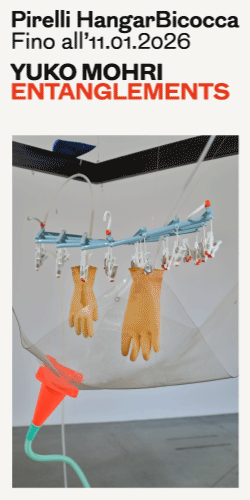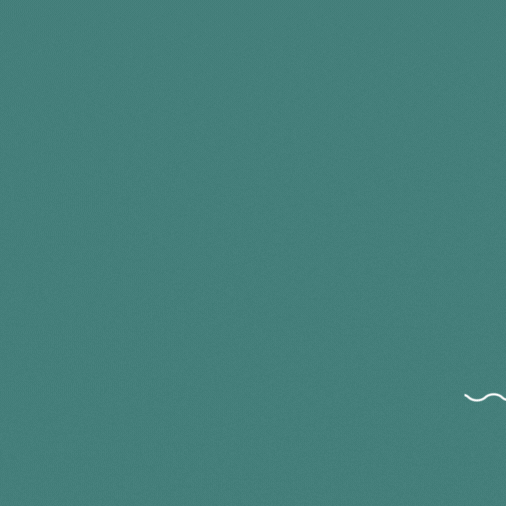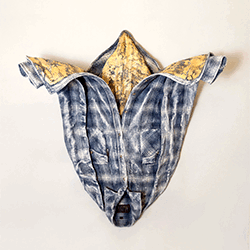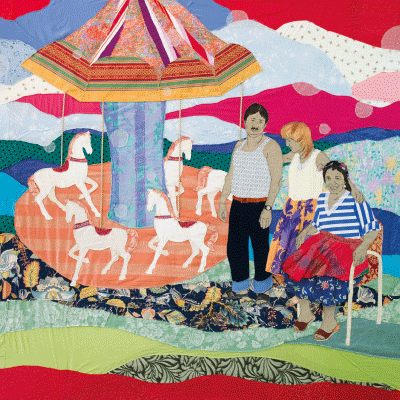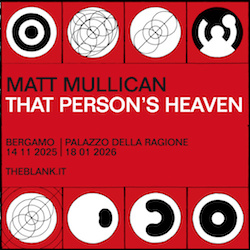
Until June 29th, Tile Project Space hosts Unknown Synergy, first solo show in Italy of Lito Kattou, the Cypriot artist who recently won the first edition of the Ducato Prize, based in the Piacenza area. The Milanese space is invaded by undefined creatures (the ‘Bodies’ series) halfway between human-anthropomorphic figures and beings from another world. What about if they came from the future? And what if we were in the past, and they were atavistic characters, or any preserved remains, impressions, or traces of any once-living thing from a past geological age? Next to them, the ‘Flowers’ series’ elements – dried and dehydrated flora collected by the artist in the Mediterranean area – lie on the wall. Are they weapons, hunting tools, or even amulets? Maybe they are guardians and no-human entities in mythological traditions and histories, coming from the long past until today.
Except for the ones on the right wall at the entrance – which recalls an essential, almost meditative place – both the series ‘Bodies’ (made of permanent ink, markers and acrylic) and ‘Flowers’ (then covered with copper) seem to be displayed in the exhibit as a sort of unique installation, as a sort of creature in a single habitat. Moving through the space filled with questions about who these beings are, and what they do, silvery and metallic reflections and other colored shades are captured on the shiny wall tiles. This decorative aspect is combined with the element of writing, which once again plays between the perception of a future and a past world. These flora and fauna not only have their presence, but also have their own language: a cuneiform writing made of ancient alphabet and modern tags. They’re stratified artworks moving on horseback of a no longer anthropocentric future.
Irene Sofia Comi interviewed both the artist Lito Kattou and the curator Mattia Giussani, talking about many aspects of the exhibition, relating it to the winning of the Ducato Prize’s first edition. As follows, the conversation goes on speaking also of their respective researches and their ideas of synergy between human and no-human, the ecological realm we live in and
the future communication a no-anthropocentric reality.


Irene Sofia Comi: Combining two-dimensional and three-dimensional, the exhibition matches two different sculptural types: the four ‘bodies’ and the five ‘flowers’. Why have you decided to combine these works, which become part of a single environmental creature?
Lito Kattou: This is a new series of works, bodies in a composition of human and inhuman elements, technological parts, imagery derived from nature, all come together in an attempt to think of a new form of creatures which deal in constant adaptability and transformation to new environmental forces. The works are processed with hand painted drawings of landscapes, animals, insects, symbols and language traces. What they are carrying as an ‘epidermis’ but also the copper electroformed thistles, are perceived as “equipment” or as presents which are carried to be given to other bodies, which will be found during a transcendence wandering, presents which are given already by other beings to them, or attributes, adornment and skills. What is happening on the aluminum surface is what is going on in their inner worlds, the psyche of those beings. All this information carried by them is about their capacities, their characteristcs, their origins.
Mattia Giussani: Speaking to Lito about the possibility of a new series of works for the show, we both had a common goal on how and what would be the best representation of this new ecological condition we find ourselves in, where we see a growing and bounding interconnection between different forces and entities. Looking at Lito’s both ‘bodies’ and ‘flowers’ series, I didn’t consider them as different works, but personally saw them as one body of work. As Lito previously explained, the artworks are so meticulous and full of details, each complementing one another, bringing aspects and themes that worked if placed in a sort of dialogue, rather than being isolated or shown in different way. These relations of different creatures in a single space is what the contemporary ecological condition is all about: a new synergetic environment of different agencies and organisms that generate new types of figures and configurations.

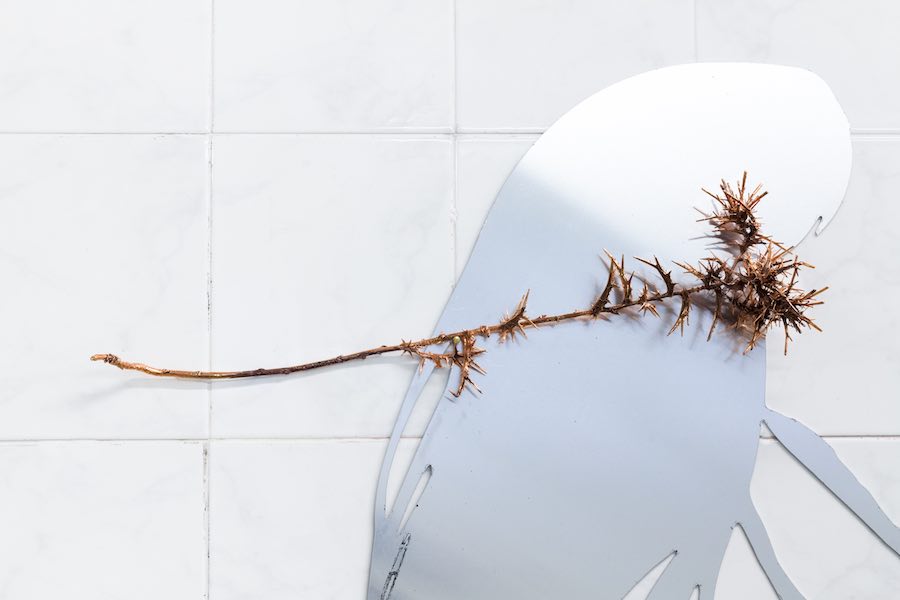
ISC: The signs and symbols present in the works are what fascinates me the most. They seem to move between two very specific spheres of interest, a sort of technological mythology and a close bond with reality. They are compositions made of liquid and asexual beings, whose natural and terrestrial shapes look at the same time at a world of origins. What do they want to tell us?
LT: I am very much interested in the idea of language as a ‘ruin’. In a constant state of flux nothing remains the same and I am always fascinated by the idea of how language is changing in a subtle silent way due to social, economic and historical aspects. If historically we are facing the moment of technological ability to its peak and simultaneously of a total ecological destruction, then probably language is affected by all these changes too. And ‘ruins’ or fragments will be the ones which will be used as tools to re-establish communication in new regimes and conditions. As already mentioned before, all imagery carried by those bodies reveal their stories and at the same time relate them to each other and the viewers. Symbols, signs, drawings and language fragments function as bridging to the Other, as communication pathways directed to a not anthropocentric future where hierarchies are fluid and dominant constitutional narratives are abolished.
MG: Language and symbols are the basis in passage of knowledge, which humans have used through many different millennia. With technological advancements, ways of communicating have changed and a key word, as Lito explained, is the fluidity in which information passes to one another and forms bridges. We can see this through the different ways in which Lito communicates the diverse features and ideas that each ‘body’ brings with itself. These bodies can be considered as archaeological artefacts for future generation to discover and more importantly, these bodies represent the embracing of a fluid communicative expression, overcoming humanistic norms.
ISC: It seems to me that for you, Lito, June has been a month full of triggers in Italy: in addition to your first solo show Unknown Synergy, you won the Ducato Prize first edition with Skins and Feathers IV Vol.2, formally speaking, a more minimal work, less decorated, which focuses on the sculptural plane more abstract and less linked to the real world. Do you find yourself in my perception?
LT: The work which was nominated the Ducato Prize comes from a project quite important for the timeline of my recent practice. San, a liquid, ungendered being between a human, a machine, a god and an animal, is conceived as an Artificial Intelligence. It reflects and negotiates the presence of creatures, guardians and no-human entities in mythological traditions and histories spanning from the long past until now. Skins and Feathers from the creatures’ digital epidermis are extruded from its body and are presented as sculptural planes. The creature is related to an ancient copper mine, in my hometown Nicosia in Cyprus, higly affected by ecological destruction developing dramatically in the South Eatern Mediterranean. The creature’s brain is designed to collect real-time climatic data from the spot and as an AI being and through its sculptural manifestations, it incarnates new forms of adaptive intelligences related to current ecological issues and raises questions on the complex relationship of nature and technology.


ISC: Beyond purely aesthetic aspects, the same conceptual items come back behind each artwork – the Ducato one and in the “Body” series. I’m talking about the relationship between nature and technology, artificial intelligence and ecology. I turn to both of you: what do you think of these tensions? How do you investigate them in your respective research?
LT: The relationship of technology to nature and vice versa interests me a lot as the project I was mentioning before reveals. I think it is a domain which will unfold more and more as we get new information from nature’s reactions to the climatic change and of technologies capacity to deal or not with it. Currently we might be in a very early stage of examination, which paradoxically might make it too late at the same time to contribute. But at least there might be tools which can be thought not only in a way to overcome destruction but mainly as a way to find new methods of adapting and “staying with the trouble” as Donna Harraway very thoroughly declares. I would say that art and artworks related to those topics are not enough to change things. Of course, they raise consciousness and they might research new areas of the topics or give solutions in an abstract way or even a scientific one, but it is very important for responsibility to shift to a governmental state. Ecology is not only about individuals recycling is about radical decisions to be taken by the ones in power universally.
MG: Having the posthuman field as my starting point, the investigation of interrelations between technology, nature and human is the core of my own artistic and curatorial research. I totally agree with Lito regarding the speed in which the different theories pop up as different events of both ecological and technological transformations occur. To give an example, just think about all the different “–cenes” terms have been coined in the last few years that tried to deal with these continuous transformative happenings. Texts that are written 2/3 years ago can be totally irrelevant if certain events or facts taking place makes them of little account and of course, art and artworks don’t have the kind of power to drastically change things, but they must raise consciousness and awareness around certain topics, especially if this just mean creating dialogue on possible solutions the can be applied to a broader socio-political agenda.
ISC: Connecting to these topics and closing the conversation up, I’d also like to talk about the title of the exhibition. According to your views, how is expressed the synergy between human and no-human? In which direction are we going or should we go in order not to break this interconnection, which seems to shape up as a perennial and increasingly unfathomable transformation?
LT: The title is a proposition of embracing synergy in the areas where it lies unknown. This should be done with openness and generosity to the Other, whether it is a human, a no human, the landscape, a companionship animal or not. We need to focus on adaptability and transformation so to enhance the idea of a no-anthropocentric future. Hope is constitutional for synergies to be established even for the ones that remain unsaid and are never declared. But those are the most magical ones I believe. A communication, a synergy beyond words.
MG: I personally think the title is what best sums up Lito’s understanding and effort in describing this ongoing synergy between different factors in the contemporary ecological realm. It’s not just embracing this synergy, but highlighting and making what is occurring nowadays visible. The point of interactivity and interconnection has already been triggered, so I believe it’s not even the point of breaking this synergy, since it’s unbreakable at this point, but how through acts of care and resistance one can be transformed and understood in order to make it feasible and sustainable for all the factors involved. Without a new collective approach of resistance against the techno-capitalistic dominating forces, this ‘synergy’ would be just for their economic advantages.



